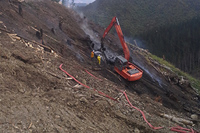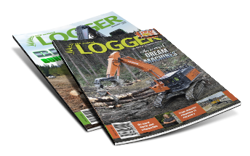
New Zealand is not shielded from periods of extreme wildfires generally associated with Australia or North America. The annual average direct financial impact of unwanted forest and rural fires on New Zealand's economy in 2020 was $142 million, with indirect costs estimated to be at least two to three times this.
To suppress unwanted fires within a forest landscape, the forestry industry has access to heavy machinery used for harvesting, road building/maintenance, and the formation and maintenance of fire breaks. This equipment becomes a valuable resource and an effective means to assist in the containment of any unwanted forest wildfires. Within this environment, the fire suppression equipment technology trends have changed little over the last 50 years. Forestry resources such as bulldozers, diggers, forestry crews, 4x4 fire tankers/vehicles, etc, remain as a practical in-forest resource for the tasks associated with the containment of fires which threaten the forest environment.
During initial and extended attack scenarios, tasks performed include direct and indirect tactics, fire breaking, mop-up, rehabilitation and hazard reduction. The forestry industry also has a workforce of more than 3,000 persons engaged in forest management, planting and silvicultural work. The majority of this forestry workforce are trained in forest firefighting and hold the required skills and awareness for safely working within and around a tall timber environment.
Incorporating aircraft
Over the past five years, there appears to be a trend that aircraft are becoming the leading tool in suppressing unwanted fires in our forest and rural landscape. With this increase in aircraft comes a threefold increase in expenditure to fund the costs of aircraft. Is this noticeable change the best use of resources in the containment of our future unwanted vegetation fires? To help understand the use of aircraft in forest fire management perhaps an awareness of the past and recent history would be useful.
The first aircraft used in New Zealand for forest fire management purposes was in a surveillance role at the Eyrewell Forest fire in 1943. Planes were first routinely used for fire patrol duties in the Rotorua district in 1943. Early in 1944, very dry conditions prevailed, and the haze and smoke caused assessment difficulties. Given the prevailing fire danger conditions, the New Zealand Air Force provided an aircraft to the New Zealand Forest Service for general patrol duties and an Oxford aircraft, later replaced when a Harvard was assigned for this purpose. It was based at Rotorua Airport and flew with a Forest Service officer as an observer. At this stage, there was no radio on board that could communicate with Kaingaroa Forest HQ, and reports were phoned through after landing.
Following the Second World War, there were plenty of ex-military pilots and planes. Aerial top dressing of fertiliser became established in New Zealand's rural areas. A newspaper article claimed that the first water bombing trials in the South Island were undertaken at Lincoln in January 1956. The trials were sponsored by the Soil Conservation and Rivers Control Council with the cooperation of Canterbury Agriculture...





